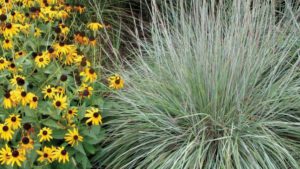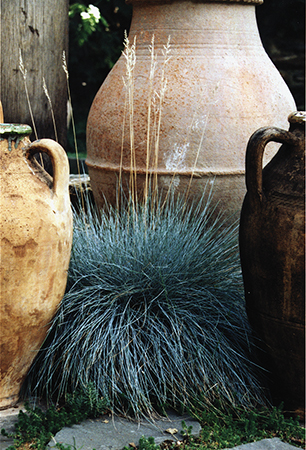How Ornamental Grasses and Sedges Can Play a Role in Pollinator Gardens

Little Bluestem species (Schizachyrium scoparium) and their cultivars are host plants for butterfly species. Pictured: Schizachyrium scoparium ‘The Blues’ Photo courtesy of Hoffman Nursery.
Grasses and sedges play an important role in pollinator gardens in less obvious ways than other plants. They provide food, shelter, and support for pollinators and the birds and mammals that keep insect populations in balance.
Ornamental grasses are tremendously popular because they are easy to grow and provide three seasons of interest, says Peggy Anne Montgomery, Brand Manager at American Beauties Native Plants, who says they act as host plants for butterflies and skippers and provide cover in the winter. They are also a good seed source for birds.
“People still aren’t thinking about grasses and sedges in the context of pollinator gardens because they don’t have obvious flowers,” says Shannon Currey, Marketing Director for Hoffman Nursery in Rougemont, NC.
“They’re often left off the hit lists. However, we are seeing them appear more on the lists lately. And they do play an important role. One of our goals is to educate our customers and their customers about grasses and sedges as foundational plants for pollinator gardens.”
Native ornamental grasses are starting to take off, but there is still a need for varieties with better ornamental appeal to keep the movement going, says Josiah Raymer, General Manager at Emerald Coast Growers.
Fortunately, breeders are beginning to show more interest in native grasses, with the result that grasses such as Andropogon, which landscapers once considered more of a workhorse than a looker, is now both. They’re also bringing out highly ornamental varieties of Panicum and Schizachyrium.
“Where before many of the native cultivars tended to be similar and mainly had incremental improvements, we’re now seeing leaps in cultivar appeal,” Currey says. “For example, little bluestems with deeper, richer color and resistance to lodging or flopping over when placed in rich or well-irrigated soils. These new selections are getting people excited about native plants, and that’s good for us and the customer.”
In non-native grasses, Emerald Coast Marketing Manager John Friel says there’s a growing interest in new infertile varieties of the most popular, established genera — Miscanthus and Pennisetum.
There is also a surge of interest in Carex, not technically a grass but in the grass category. While Carex aren’t as flashy as other ornamentals, they can be incredibly useful in pollinator gardens as host plants and as support for successful plantings, Currey says.
“There is a sedge for just about any site condition, and many sedges provide wildlife services,” says Kyle Banas, Nursery Manager and Head Grower at Pizzo Native Plant Nursery in Leland, IL. “Sedges with great landscape potential are often overlooked in production and provide food for an astounding variety of wildlife, including pollinators. Carex jamesii is a great example. It has a nice mounding habit and stays compact. Here in the Midwest it greens up early and tends to hold its color through the summer and well into the winter.”










